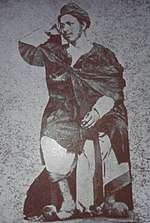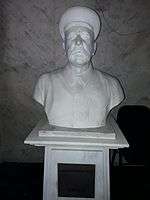Govardhanram Tripathi
| Govardhanram Madhavram Tripathi | |
|---|---|
|
Govardhanram Tripathi | |
| Born |
20 October 1855 Nadiad, Bombay presidency, British India |
| Died |
1 April 1907 (aged 51) Bombay, Bombay presidency, British India |
| Nationality | Indian |
| Occupation | Novelist, lawyer |
| Known for | Saraswatichandra |
Govardhanram Madhavram Tripathi was an Indian Gujarati language novelist of the late 19th and early 20th centuries. He is known for his four volume novel, Saraswatichandra, acclaimed as one of the masterpiece of Gujarati literature. The novel represents the life of Gujarat during the early part of 19th-century.[1]
Life

Govardhanram Tripathi was born in on 20 October 1855 on the day of the Dashera festival.
He completed his BA degree in 1875 and LLB in 1883. He started working as a lawyer in Mumbai in 1884.[2] At the age of 43, he retired early and settled in his hometown to contribute to Gujarati literature and public service.
Govardhanram Tripathi died in Mumbai on the evening of 4 January 1907.[2]
Literature

In 1887, the first volume of Saraswatichandra was published, and was followed by volumes 2, 3 and 4 in 1892, 1898, and 1901, respectively; each volume have a separate subtitle: The Administration of Buddhidhan, The Family-maze of Gunasundari, The Political Administration of Ratnanagari and The Dreamland of Saraswati.[1] The novel represents the life of Gujarat during the early part of 19th-century and also focuses on contemporary social, political, philosophical and cultural issues. It is believed that Govardhanram has sketched his own various personality through this novel.[3]
He also took an active role in the Indian Congress during 1902; and in 1905, he was elected as the first president of Gujarati Sahitya Parishad. He also wrote various articles and essays in the papers 'Vasant' and 'Samalochak', which were later published as books.
His other works includes Snehamudra, Leelavati Jeevankala (Lilavati's Art of Living), Navalramnu Kavijeevan (Navalram's life as a poet), Dayaramno Akshardeh (The Literary Works of Dayaram), Sadavastu Vichar, Classical Poets of Gujarat and Scrap Book, an autobiographical work.[1]
Legacy
The period from 1885 to 1915 is called "Govardhan-Yug" or "Govardhan-Era" in Gujarati literature. On 27 April 2016, a commemorative postage stamp was released by Indian Posts to honour Govardhanram Tripathi. The Chief Minister of Gujarat, Anandiben Patel, released the postage stamp in Gandhinagar.[4][5][6]
Further reading
- Pandya, Kantilal Chhaganlal (1965). Pandya, Upendra, ed. Sriyut Govardhanram (in Gujarati) (2nd ed.). Mumbai: N. M. Tripathi Pvt. Ltd.
References
- 1 2 3 R. P. Malhotra (2005). Encyclopaedic Dictionary of Asian Novels and Novelists: A-I. New Delhi: Global Vision Publishing House. p. 290. ISBN 978-81-8220-067-8. Retrieved 15 March 2018.
- 1 2 Salil Tripathi (2013-03-30). "Saraswatichandra-Not a love story". livemint.com. Retrieved 2013-11-14.
- ↑ Mehta, Chandrakant (2005). Indian classics - Gujarati. Translated by Maru, Pallavi. New Delhi: Publications Division, Ministry of Information and Broadcasting, Government of India. pp. 1–2. ISBN 978-81-230-1120-2.
- ↑ "Gujarat CM releases postal stamp of Shri Govardhanram Tripathi". DeshGujarat. 2016-04-27. Retrieved 2018-03-14.
- ↑ "Stamp Released on Gujrati Writer Govardhanram Tripathi". PhilaMirror. 2016-04-28.
- ↑ http://anandibenpatel.com/en/gujarat-cm-launches-postal-stamp-memory-shri-govardhanram-tripathi/
External links
- Govardhanram Tripathi on GujLit
- Govardhanram Tripathi at Goodreads

